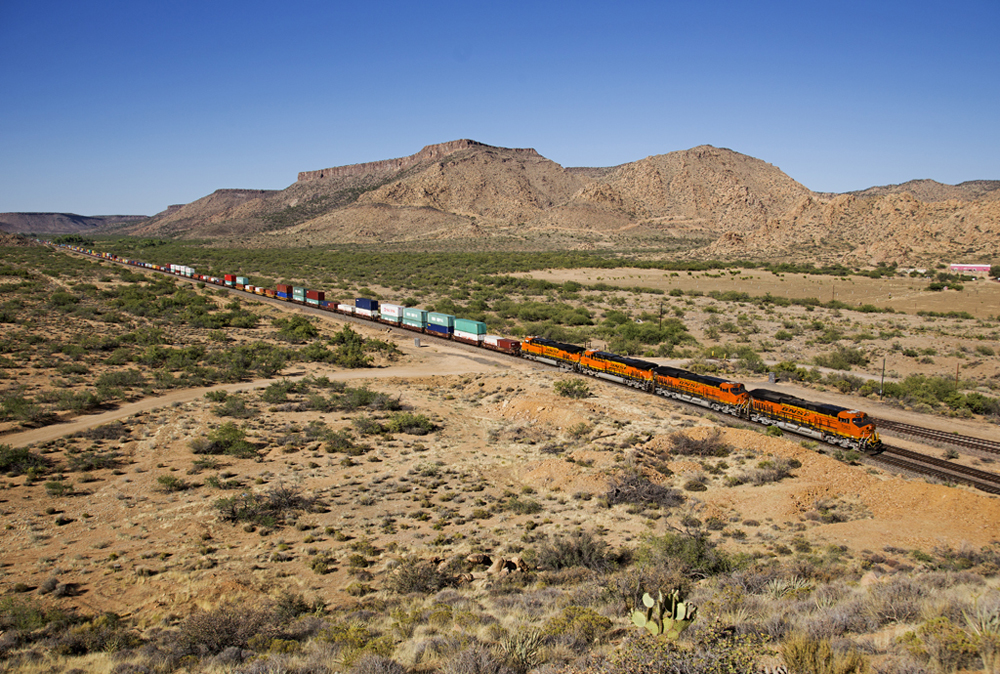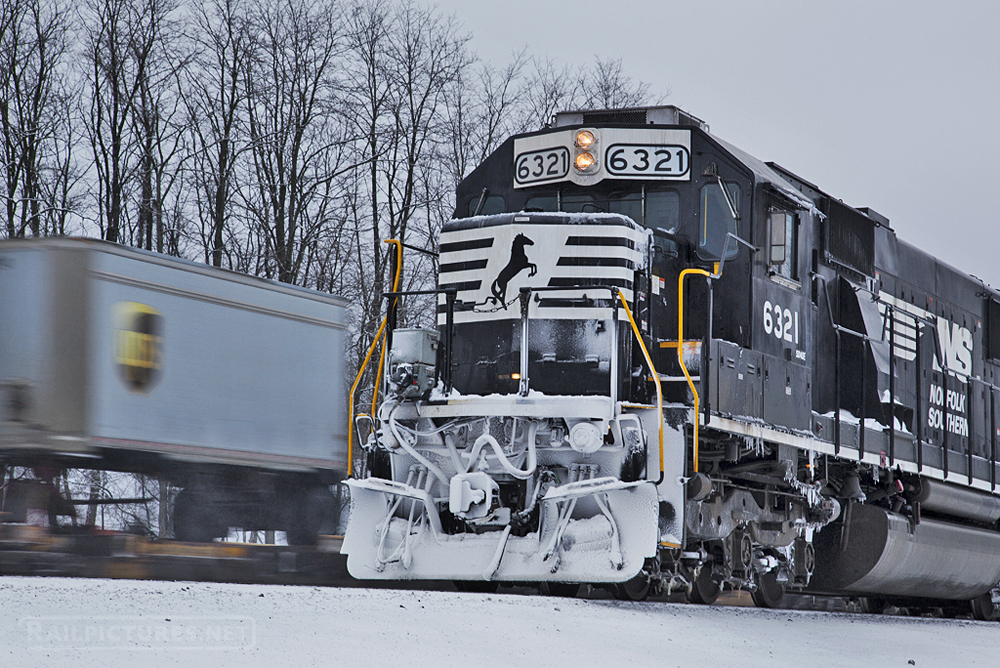
CHARLESTON, W.Va. — Most large U.S. railroads are handling more intermodal this year as geopolitical issues and domestic port labor talks weigh on how importers move containers.
Each Class I railroad’s intermodal business, with the exception of Canadian Pacific Kansas City, is outperforming last year. BNSF Railway is leading the pack, up 394,000 units, or 16% year over year. Union Pacific is up more than 59,600 units or 3%; Norfolk Southern up 145,700 units or 7%; CSX Transportation up 72,000 units, or 4%; and Canadian National up 97,100 units or 8%. CPKC reports a 6% decline year over year, or 60,500 fewer units, according to the most recent weekly carload data compiled and published by each major railroad.
Twenty-foot equivalent units (TEUs), an industry container measurement, also inched up in June, signaling an earlier than expected seasonal peak, with volume shifting primarily into West Coast ports, according to Larry Gross, intermodal and freight transportation analyst.
“Volume shifted towards the U.S. West Coast amid continued problems in the Red Sea and the ongoing stalemate in east coast labor talks. The [Pacific Northwest] in particular saw gains from diverted cargo,” says Gross in his July 2024 research analysis, citing port data from S&P Global.
Container ships are avoiding Houthi militant groups in the Red Sea by detouring around South Africa, adding 10 to 14 days travel time. The terrorist group has attacked more than 60 merchant vessels since mid-November.
At the same time, negotiations between East and Gulf Coast port officials and union leaders representing thousands of American dockworkers, container carriers, and other port workers, have stalled out, raising concerns of work stoppages as soon as the current contract expires on September 30th. Three-dozen ports are affected by the negotiations, including the Port of New York and New Jersey, the Port of Savannah, the Port of Houston, and three more of the top 10 busiest ports in the U.S., according to InTek Freight & Logistics Inc.
These circumstances and the uncertainty around their outcomes may explain why railroads’ intermodal franchises have fared better in 2024’s first half than a year ago, as Gross believes a fairly substantial percentage of this volume is being upstreamed from later in the year.
“There are ample reasons for importers to move their cargo early,” he notes.
According to Gross’ July 2024 research, international intermodal is up 7% year over year, while domestic business is down less than 1% compared to a year ago. Of the domestic portfolio, containers are up 1% and trailers are down more than 23%.

UPS, a major TOFC rail customer, reported less revenue in its recent second quarter results, citing current volume momentum headwinds and a consumer shift to cheaper shipping methods.
“Domestic intermodal is suffering from a demand issue right now,” says Gross.
“There is plenty more capacity, but the industry is finding it difficult to regain shippers that were lost during the 2022 meltdown. The combination of current levels of service, route coverage and pricing appear to have reached a market ceiling,” adds Gross.
“This is concerning because domestic intermodal is really the only place where the railroad industry controls its own volume destiny.”
Despite the macroeconomic headwinds affecting domestic business, railroads continue to fixate on network efficiency, a prerequisite to gaining shipper confidence and pivoting to growth. U.S. intermodal train speeds and dwell are mostly trending in the right direction.
Intermodal train speeds are slightly below five-year averages, but terminal dwell is considerably below five-year historicals, according to mandated service metrics provided by railroads to the Surface Transportation Board.
BNSF intermodal train speeds are on par with its five-year averages, and its number of trains holding, carloads not moving, or cars online have decreased. In other words, the railroad has improved intermodal velocity at a time when its volumes are up double-digit percentages.
UP’s intermodal train speeds have decreased in recent weeks, with the railroad citing weather, but its number of trains holding and cars not moving are below five-year norms.
In the East, CSX is slightly below its five-year average for train speeds and the railroad saw a recent spike in the number of intermodal trains held for reasons like crew and power. Carloads not moving and intermodal cars online are trending favorably.
NS intermodal train speeds are above five-year averages and the number of trains holding are trending well below historical norms.
CN’s U.S. intermodal train speeds are mostly on-par with historical averages, and trains holding, carloads not moving, and intermodal cars online are below the average. And CPKC’s metrics are still being reported to the STB separately, but are similar. Canadian Pacific and Kansas City Southern have both seen decreased train speeds and increased terminal dwell in recent weeks.
Gross says maintaining adequate levels of service consistency is simply what is needed to get intermodal into the game.
But it’s not all about dwell — it’s about dollars, too. Railroads will have to price competitively to sustain and grow volumes in a soft market.
“No one will use intermodal because it is consistent, as even the best intermodal service is at best on par with truck and likely less consistent,” he says.
“It’s also almost always slower but that’s okay if it’s priced right.”














One factor left out of the pricing/cost equation is highway subsidy. We all know that the Highway Trust Fund has not covered their budget for many years. And even if taxes rise to cover costs, there is still the fact that no highway in the USA pays property taxes as the railroads do. Not even the “private” turnpikes such as the Indiana Toll Road pay property taxes. Plus the fact that trucks have never paid their fair share of the cost of roadway engineering and maintenance. Autos pay the lion’s share and always have. If these costs were allocated as they should be, railroad intermodal would be the low-cost leader, hands down.
Nice bunch of theoretical nonsense but totally irrelevant to this discussion of the real time, real-world transportation marketplace. Gues what? THE CUSTOMERS/SHIPPERS DON’T CARE!
Remember that if you got a truck brought it.
To borrow an old political slogan, it’s the truckers stupid!
Most railroaders, including some in the railroad media, fail to realize that intermodal, like the trucking industry, has 100 percent pure competition. And much of that competition is driven by price. Trucking rates are continuing at a consistently low level, in fact one of the longest low levels in a very long time.
Demand for intermodal is driven by price and supply in the trucking industry as much as anything else. Chase, there is your story. In the short-term who needs intermodal when there are plenty of low-price trucks around? Right now, the trucker will give you a lower rate and service that is equal or better than intermodal.
With power being stored WHY ARE TRAINS WAITING FOR POWER? Well, I know why but the reasons are beyond my ability to comprehend…as in PULL THE POWER OUT OF STORAGE! Again, just do the basic and run the freight. The rest will fall in place.
Having the loco’s is one thing but having the crews to run them is an entirely different issue.